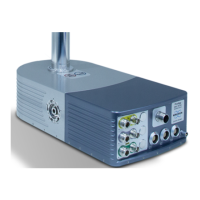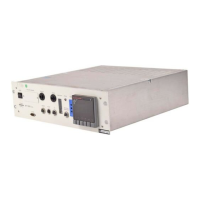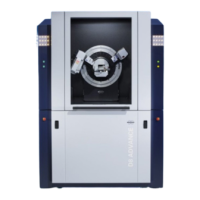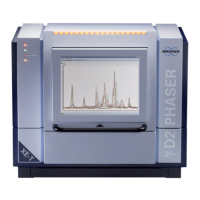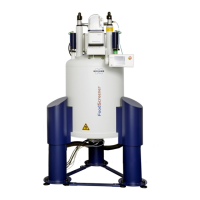Bruker Confidential Information
1.3. Basic Measurement Modes
include such activities as measuring voltages and current flow during initial set-up or maintenance
tasks. Only trained service personnel should perform tasks that require work with live electrical
equipment. Factory-authorized personnel should service all internal electrical components of the
system.
Other hazards associated with electricity include fire and arcs or flashes. Fires can be started
from the overheating of an improperly sized conductor or by electrical arcs or flashes, which occur
when an electrical circuit is suddenly short circuited (for example, when a metal screwdriver is
accidentally dropped across live electrical terminals). Arcs and flashes generate extreme amounts
of heat and can emit molten particles, potentially starting a fire or physically injuring persons in
the vicinity. Eye protection should be worn during testing or troubleshooting where live electrical
circuits are involved.
Mechanical Hazards
Mechanical hazards exist in the system wherever moving parts are located, such as slides. These
moving parts often create pinch points—areas where a person’s hand or fingers could get caught or
crushed. Moving parts can also create an entanglement hazard if the parts are large enough for part
of a person’s body to become entangled within them. Pinch-point injuries usually result in a cut or
crushed finger or hand, but can result in loss of a finger or hand. Entanglement hazards are usually
more serious and more likely to result in loss of a limb, or even death. Protection against mechanical
hazards in the ContourGT is provided in the form of physical guards such as the measurement head
cover and the system base.
Thermal Hazards
Unlike most other physical hazards, thermal hazards are not eliminated by removing power. Surfaces
may remain hot for up to 30 minutes after removing the heat source. Contact with potentially warm
or hot surfaces or components, such as lamps, motors, and heat-sinks may cause skin burns. Allow
the system to cool to ambient temperatures before attempting to remove/service components.
Pressure Hazards
Pressure hazards exist due to the difference in kinetic energy of a gas within a container or piping
system and the surrounding environment. If a sudden breach of a gas line or a pressurized container
were to occur (for example, a gas delivery line bursts), the pressure differential between the gas in the
line and the surrounding atmosphere will cause the gas to be forcefully expelled into the surrounding
atmosphere. This can cause physical injuries due to particles flying outward at extremely high speed.
ContourGT optical profiler systems use compressed clean dry air (CDA) for the vibration iso-
lation system.
The CDA fittings or components of the pneumatic system should be adjusted only after appro-
priate release of air-line pressure. As with electrical and mechanical tasks, maintenance activities
involving the air lines should occur only after appropriate pressure lockout procedures have been
implemented.
1.3 Basic Measurement Modes
The ContourGT-K OMM supports Vertical Scanning Interferometry (VSI) and Phase-Shifting In-
terferometry (PSI) measurements.
4
